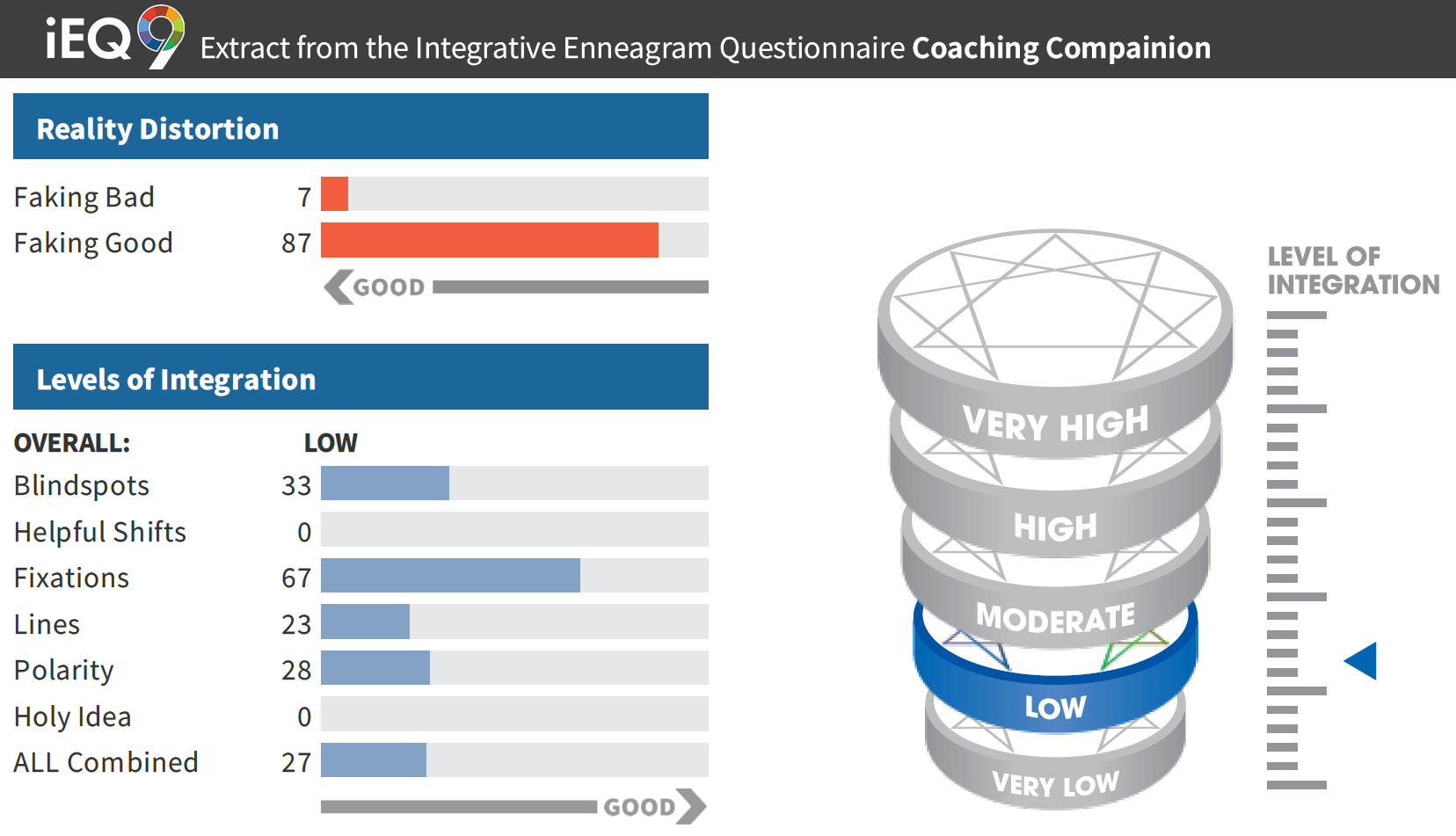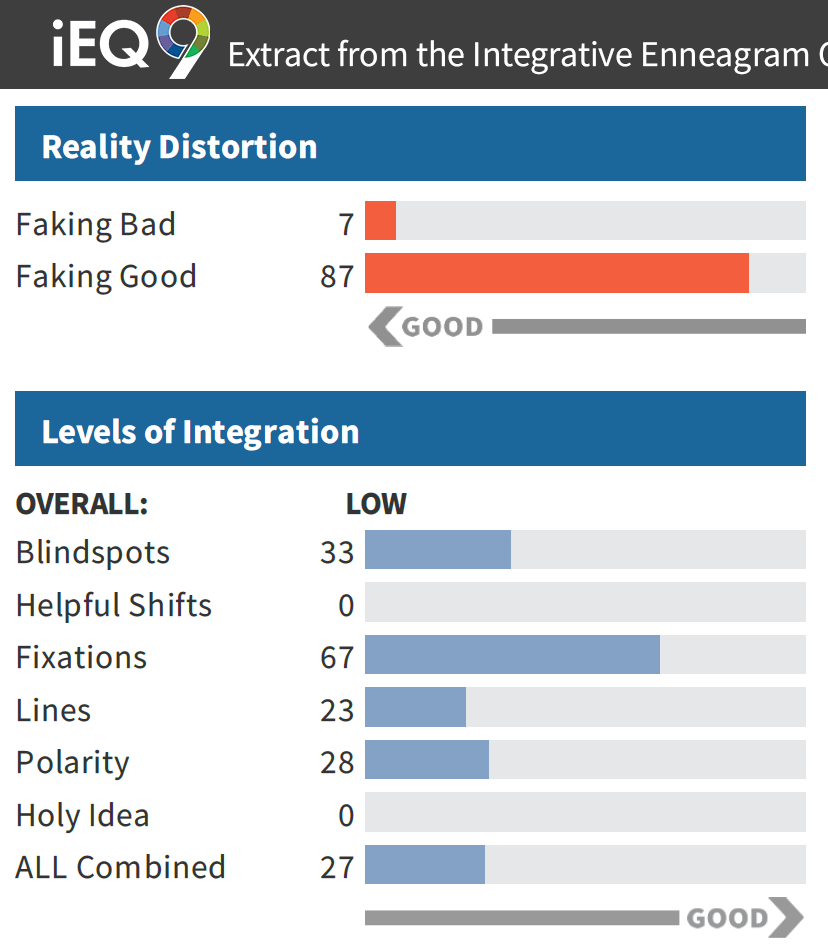The iEQ9 Integrative Enneagram Questionnaire measures and reports on a range of important dimensions of personality and effectiveness. One of the most challenging tasks is to debrief the client on their Level of Integration. Coaches often reach out to us with anxiety when they see a client with a Low Integration result, primarily because they are concerned about how the client will feel about being labelled as ‘Low’ in such a crucial area. And indeed, many clients react to the categorisation of ‘Low Integration’ with dismay.
Integrative Enneagram Solutions suggests that rather than becoming discouraged when we see a Low Integration result, we should, in fact, see it as a positive. What a Low Integration result actually indicates is that the Enneagram, and more specifically our Integrative approach to coaching and development with the Enneagram, is ideally suited to this person at this stage of their personal journey.
What Does Integration Mean?
Integration refers to levels of vertical development or growth within an Enneagram Type. The Levels of Integration are a way of describing how Types change as they explore and integrate the possibilities of the Enneagram more completely.
The unhealthier states of the Type are described as Low Integration, where the client is often fixated in the core belief of their Enneagram Type but is unaware of their Type and, therefore, of that filter. The more positive, healthy version of the Type is described as High Integration, where the client can see themselves from a distance and step out of the limitations of their Core Type with ease. In Enneagram literature, Low Integration is associated with ‘fixation’ – being stuck in the limited worldview of our Type.
At Integrative Enneagram Solutions, we work with five Levels of Integration:
At a Very Low Level of Integration, clients are often ‘dysfunctional’. This result is very rare in a conventional non-therapeutic coaching situation. These clients may be trapped in a reactive pattern, blind to how their Type fixation could be dysfunctional despite clear feedback indicating that the less-healthy aspects of their Enneagram Type are impacting their life negatively. They might agree with the statements made about the Type’s fixations and limiting beliefs, but may also argue that this is the only reasonable way of being and that not only do they not need to change, others should be more like them!
At a Low Level of Integration, people may seem almost ‘trapped’ by their Type, driven by their fixations and core fear. They have a limited ability to access other Types consciously, but may reactively access their lines under stress. These clients are likely to have significant blind spots and, while they may identify with their core Enneagram Type, they may initially have a significant aversion or emotional reaction to being typed.
At a Moderate Level of Integration, clients are more self-aware, possibly even able to self-identify their core Enneagram Type on learning about the model. They are less reactive and more conscious of their drivers and fixations, but still largely driven and motivated by the characteristics of their Type. These clients may focus on their personal development but still express frustration at their inability to change at a fundamental level.
At a High Level of Integration, clients are far more self-aware and intentional, able to ‘play’ in their Type’s Wings and Lines of Stretch and Release, accessing other energies as the situation demands. Many of the challenges and fears of their core Enneagram Type may soften and they are likely to engage with new questions that go beyond their Type, leading them to deeper exploration.
At a Very High Level of Integration, there is a sense of letting go or transcending these core fears as one outgrows the limitations of Type and ‘moves towards the Center of the Enneagram’. This Level of Integration is almost unheard of in ‘normal’ individuals but it does occur. This deep Integration and the softening of their Core Type issues can make these people difficult to Type definitively.
What the Integration Measure Includes
The iEQ9 Integrative Enneagram Questionnaire measures and calculates Level of Integration based on a holistic range of factors, any of which can create a barrier to Integration and prevent a client from realising their potential. These Integration factors reflect the specific meaning of an iEQ9 ‘Low Integration’ result:
- Blind Spots: Each Enneagram Type has a focus of attention and avoidance that causes certain typical blind spots. These are traits that others may see in them, but which they do not acknowledge in themselves. The blind spots can be thought of as the most fundamental aspect of Integration and often form the first point of intervention with Low Integration clients.
- Helpful Shifts: Each Enneagram Type holds the potential for both non-helpful and helpful behaviour shifts. This scale measures whether your client has an inclination towards the higher or lower side of the potential behaviour patterns of their Type.
- Line Access: Each Type is connected to two others by Lines of Stretch and Release which symbolise connections to perspectives that balance the Type’s fixations and present an opportunity to develop balanced behaviours. This measures the extent to which a client accesses their lines. Note that accessing the lines can be a distraction for Low Integration clients, leading them away from the core work of confronting their blind spots and patterns.
- Integrating Polarity: Each Enneagram Type represents a fixation – a narrowed view of the world and of the self. This measures how fixed or flexible a client’s self-image is – the extent to which they can see the polarities and trade-offs of their Type. Working with polarity may come up in the later stages of coaching, as we guide clients to appreciate the other side of the polarities represented by the lines and help them break down ‘black and white’ thinking.
- Holy Idea: The Holy Idea is like the antidote to the Core Type’s fixation and defines how they keep themselves trapped. Integrative Enneagram Solution’s assessment tool tests the extent to which your client can see the Holy Idea, by providing a less fixed, more pure interpretation of their Type and the world. Note that working with the Holy Idea is considered an advanced area of Enneagram exploration, and is not suitable for Low Integration clients.
While any of these elements can create a barrier to Integration, it is far more common at Low Integration to see challenges in most, if not all, of these dimensions, leading to an overall Low Integration result and room for development across the board. We offer some suggestions on where to begin with coaching around this information with your own client further on in this article.
Interpreting Low Integration
Integration is an element that we should hold and handle with care when debriefing a client’s profile. Most importantly, remember that Low Integration does NOT necessarily mean low development or self-awareness! Interpretation of this result is not as simple as “High Integration is evolved and good, whereas Low Integration is bad”. Low Integration simply indicates that, on all the specific Enneagram paths of Integration, this person still has significant potential to develop and grow.
Key points regarding Integration that may be relevant to share with your clients:
- The Level of Integration does not measure the personal work or development that an individual has done. There are many different ways to develop ourselves, and clients may have engaged in and gained great personal benefit from many different paths in their ongoing journey of growth and self-development. For example, a client may have polished their leadership skills and managed their impact on others very effectively, but still not recognised their Enneagram Type. Even those who have done extensive personal work can still trip up in the ‘blind’ areas of their fixations.
- Integration reflects how much someone is able to escape their Core Type and access or ‘step into’ other Enneagram Types. Integration requires that clients balance their action, feeling, and thinking Centers rather than being ‘stuck’ in their Type. A Low Integration result means that they are very much ‘in’ their Type – which also means that the Enneagram coaching journey that they are embarking on offers great potential for growth and release! Low Integration indicates that the Enneagram is likely to add value to their current level of awareness, offering a map to new areas to explore as well as new and different ways of being.
- The Level of Integration is only a result of the iEQ9 interpretation of information they gave – not anyone else’s judgement of them. This result is also an approximation and subject to distortions for a number of reasons. We have found, for example, that the small percentage of individuals who are highly self-aware and have done more self-development work may initially test at lower Integration as they are almost painfully aware of themselves and their blind spots and may over-report on these aspects in their answers, exaggerating their level of dysfunction.
- Low Integration may also not be a permanent state. It is more accurate to think about the Level of Integration as a ‘bandwidth’ that each of us moves up and down within – lower on bad days and higher on good days. Low Integration is also common with people in transition and/or under High Strain. A person’s true Level of Integration may also be directly affected by pressure and mindfulness, as they can access more of their gifts and be less ‘run’ by their fears if they are in a calm, mindful state.
Common Challenges Experienced by Low Integration Clients
Clients representing lower Levels of Integration may demonstrate some of the following patterns:
- Low Integration individuals often idealise certain qualities – typically those associated with their own Enneagram Type – as right and good, while judging and rejecting others. They often have a right and wrong, black and white view of the world – “being like me is good, being anything else is bad”. They are blind to their blind spots and may struggle to see other people’s point of view, without a deep awareness of the nuances and variation of human strengths. Often this assessment leaves the Lower Integrated individual feeling somewhat superior, as they measure others by their own standards and see themselves as ‘right’.
- Their relationships are typically affected because a Low Integration approach tends to try to control and manipulate their reality rather than being honest and vulnerable. This is generally a reaction to fear and overcompensation and often an unsophisticated attempt to prove themselves to others. Many people at this level manage their inner tensions and conflicts by projecting their less-desirable qualities onto others and then judging or criticising them – in a way, attempting to make themselves feel better by putting others down. For example, an Enneagram 5 with a Low Level of Integration might make themselves feel better and more knowledgeable by challenging others to intellectual battles and ‘proving’ that others are stupid and incompetent.
- At a lower Level of Integration, your client’s behaviour is likely to reflect the less-healthy and more reactive patterns of their Enneagram Type. At this level, we also often see the Vice of Type being active, along with their defence mechanisms. They may feel like a victim of their own reactions, finding themselves making the same mistakes and repeating the same ineffective behaviours over and over.
- Low Integration is often associated with descriptions such as ‘blindness’ or ‘auto-pilot’, as people at this level often operate from an automatic state, reacting without much awareness of what drives them to do so. In a Low Integration state, people are often unaware of their Type’s blind spots and how they contribute to creating their issues. Others – such as their coach or partner – may be able to see aspects of their personality that they themselves find it hard to see.
Low Integration – When to Worry
One challenge of working with Low Integration clients is that when one is operating in the Low Integration or more limited range of their Type, it is quite likely that this may cause strain and stress. Under excessive or sustained pressure or stress, Low Integration clients may be at risk for breakdown or burnout, so coaches need to be aware of their client’s capacity to stretch.
It is important to remember that a Low Integration result does not necessarily indicate a client in crisis or disintegration. Very Low Integration may indicate some of the red flags and dangers for that Type; however, this result is extremely rare.
At a Very Low Level of Integration, where the negative or dysfunctional side of their Type tends to show up very clearly, the client may be trapped in a reactive pattern, blind to how their fixation could be dysfunctional and feeling desperate or highly frustrated.
For example, a Low Integration Enneagram 2 is likely to take criticism too hard, often responding with blame or guilt. Their relationships may take strain as they both question their self-worth and also feel unappreciated and taken for granted by others, criticising them as a result. Their suppressed feelings and unmet needs may lead to fatigue and more frequent illnesses. For Low Integration clients, we advise that coaches check in on the client’s strain levels. If a client is Low Integration and extremely High Strain, you might consider either referring them for additional support or focusing on supporting and containing their strain level before continuing with coaching.
At Very Low Integration, Enneagram 2s may begin to show the warning signs of excessive self-doubt, believing that their worst fears have come true and that they are driving their friends and loved ones away. Their sense of being taken for granted by others may lead to strong feelings of resentment and anger. They may feel that their health is falling apart and exhibit lack of sleep and chronic illnesses. Clients who test at Very Low Integration are likely to need additional therapeutic, medical or other support and may be candidates for referral.
Coaching Low Integration Clients
The Level of Integration indicates the extent to which one has been able to synthesise and access all the various aspects of their Enneagram profile as a result of their personal development journey so far. When working with clients, remember to contextualise their Integration result very specifically within the Enneagram context. This may allow you and the client to reframe Low Integration as a signal that the work and insights of the Enneagram are ideally suited to them at this point.
Self-awareness is the first step in transformation, and coaching Low Integration clients should focus on compassionately growing their self-awareness by guiding them to discover their Enneagram Type. By looking back and seeing themselves through the lens of the Enneagram, they may become more aware of their patterns. This will require work to challenge and illuminate the blind spots and defence mechanisms that keep them stuck.
As they integrate, clients will begin to shift their perspective, becoming aware of their filters and fixations and, therefore, beginning to see their Type and paradigm as just one way of being amongst many. This opens the door for them to begin the work to expand their being, moving into Moderate Integration as they strive to balance how they access the Centers, Instincts and Enneagram styles.
The Enneagram does not provide a ‘quick fix’ with a limited lifespan once insight has been reached; it enables people to develop themselves over time as the Enneagram continues to speak to them as they and their circumstances change. As they integrate, their self-awareness and ability to choose their responses, rather than react, will increase and many of the core challenges and fears related to their Enneagram Type may soften and new questions will emerge – leading them into their next level of self-discovery and Integration.

 What is the Enneagram?
What is the Enneagram?
 Introduction to the 27 Subtypes
Introduction to the 27 Subtypes
 Introduction to the 3 Centers
Introduction to the 3 Centers
 Wings
Wings
 Lines and Integration
Lines and Integration
 Enneagram History & Origin
Enneagram History & Origin
 Enneagram for Myself
Enneagram for Myself
 Enneagram for Practitioners
Enneagram for Practitioners
 Enneagram for Business
Enneagram for Business
 iEQ9 Individual Reports
iEQ9 Individual Reports
 iEQ9 Team Reports
iEQ9 Team Reports
 iEQ9 Questionnaire
iEQ9 Questionnaire
 Training Events
Training Events
 Level 1 iEQ9 Accreditation
Level 1 iEQ9 Accreditation
 Level 2 Enneagram Team Dynamics
Level 2 Enneagram Team Dynamics
 International Enneagram Conference
International Enneagram Conference
 iEQ9 Community of Practice Events
iEQ9 Community of Practice Events
 About Integrative9
About Integrative9
 Meet the Faculty
Meet the Faculty
 Testimonials
Testimonials
 Contact Us
Contact Us





